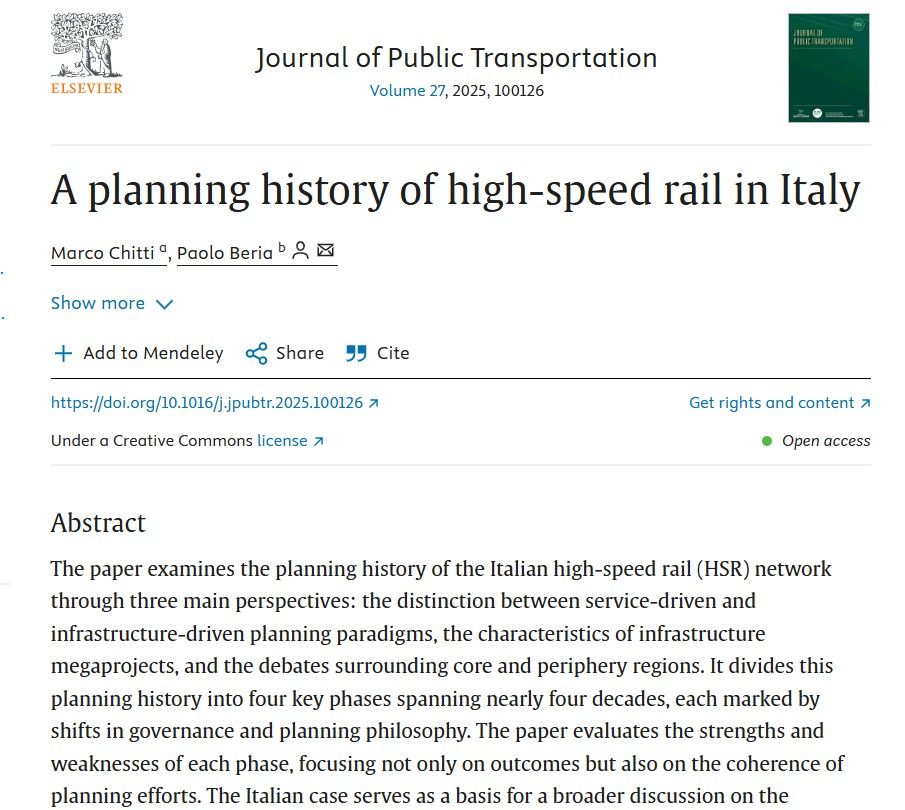https://marcochitti.substack.com/

It's open source, so you can read it at length (it is pretty long),
But here is a TL;DR: 🧵
www.sciencedirect.com/science/arti...
Give a follow to @dralbertazziuk.bsky.social for non superficial insights into contemporary Italian politics.
One wants more powers (including of taxation) for northern regions. It is the old guard of the party, such as former Governor of Veneto region Zaia. It has achieved an impressive result in Veneto regional elections
Give a follow to @dralbertazziuk.bsky.social for non superficial insights into contemporary Italian politics.




La rame en direction D-M est pleine (plus de places assis), à 13h un samedi.
Le gens ne realisent pas assez la puissance de l'effet réseau.
La rame en direction D-M est pleine (plus de places assis), à 13h un samedi.
Le gens ne realisent pas assez la puissance de l'effet réseau.
(Via Riva Reno, Bologna, reopening today after the extreme makeover linked to the tramway works)
Pics not mine.




(Via Riva Reno, Bologna, reopening today after the extreme makeover linked to the tramway works)
Pics not mine.




The brand new 't Oor bus terminal in the southern periphery of Almere, built atop a highway bridge. A nice place to catch a bus, I guess.




The brand new 't Oor bus terminal in the southern periphery of Almere, built atop a highway bridge. A nice place to catch a bus, I guess.
Mais planifier la circulation, ah ben non pas ça, on fait pas ça comme ça icitte!

Mais planifier la circulation, ah ben non pas ça, on fait pas ça comme ça icitte!




Transit-and-local-access-only street or transit- and local-access-only street?

Transit-and-local-access-only street or transit- and local-access-only street?




@holz-bau.bsky.social



@holz-bau.bsky.social
The national archeological SoPrintendenza fighting with the local special SoVrintendenza about who's going to manage the in-station museums of the soon-to-open MC extension.
(Yes, Roma has a special local archeological protection authority, for reasons)


The national archeological SoPrintendenza fighting with the local special SoVrintendenza about who's going to manage the in-station museums of the soon-to-open MC extension.
(Yes, Roma has a special local archeological protection authority, for reasons)
If you search for low-traffic neighborhoods, you find 100s of articles on the most disparate related topics.
If you search ZTL or limited traffic areas or zones: 🥱
If you search for low-traffic neighborhoods, you find 100s of articles on the most disparate related topics.
If you search ZTL or limited traffic areas or zones: 🥱
The new road code was written in 1991 (and transit signals and directional lights existed even before...)


The new road code was written in 1991 (and transit signals and directional lights existed even before...)
I think I found the sentence that perfectly encapsulates the ethos of public services in Canada.
montrealgazette.com/news/local-n...

I think I found the sentence that perfectly encapsulates the ethos of public services in Canada.
montrealgazette.com/news/local-n...
(...)
Bologna non deve soffocare
The city administration believes that the only solution is to reduce the use of private vehicles wherever possible. Increased speed and frequency of public transportation, as well as free travel during certain time slots, could make travel easier."

(...)
Bologna non deve soffocare
The city administration believes that the only solution is to reduce the use of private vehicles wherever possible. Increased speed and frequency of public transportation, as well as free travel during certain time slots, could make travel easier."
They really don't like to handle cash, especially coins.


They really don't like to handle cash, especially coins.
Regional elections went as expected.
Veneto: R
Campania, Apulia: L
Apulia regional presidential election
Decaro (PD-S&D): 64.6%
Lobuono (*~EPP|ECR|PfE): 34.5%
Donno (PCI~LEFT): 0.7%
Mangano (*): 0.2%
➤ europeelects.eu/italy
#Puglia #Regionali2025

Regional elections went as expected.
Veneto: R
Campania, Apulia: L
Don't get me wrong, biking in Bologna is ok, but mostly despite public policies or as a collateral consequence of urban history and traffic management

Don't get me wrong, biking in Bologna is ok, but mostly despite public policies or as a collateral consequence of urban history and traffic management
They are part of a broader effort to harmonize transit wayfinding across the region between all providers.
They are part of a broader effort to harmonize transit wayfinding across the region between all providers.
📸: Alfred Pearson
City of Toronto Archives
#OTD #OnThisDay #1920s #streetcar #transit #torontohistory #toronto #canada #hopkindesign



SBB/CFF/FFS: we are raising the existing canopy at the Gare de Lausanne by 1 m and move it laterally by 90 cm to slightly modify the tracks' geometry.
youtu.be/CNuJLQguRgo?...

SBB/CFF/FFS: we are raising the existing canopy at the Gare de Lausanne by 1 m and move it laterally by 90 cm to slightly modify the tracks' geometry.
youtu.be/CNuJLQguRgo?...
They are manufactured by the Turkish Bozankaya.
youtube.com/shorts/ahrCq...

They are manufactured by the Turkish Bozankaya.
youtube.com/shorts/ahrCq...


